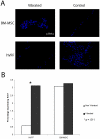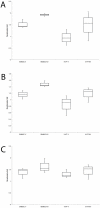The response of vocal fold fibroblasts and mesenchymal stromal cells to vibration
- PMID: 22359557
- PMCID: PMC3281043
- DOI: 10.1371/journal.pone.0030965
The response of vocal fold fibroblasts and mesenchymal stromal cells to vibration
Abstract
Illumination of cellular changes caused by mechanical forces present within the laryngeal microenvironment may well guide strategies for tissue engineering the vocal fold lamina propria. The purpose of this study was to compare the response of human vocal fold fibroblasts (hVFF) and bone marrow mesenchymal stem cells (BM-MSC) to vibratory stimulus. In order to study these effects, a bioreactor capable of vibrating two cell seeded substrates was developed. The cell seeded substrates contact each other as a result of the sinusoidal frequency, producing a motion similar to the movement of true vocal folds. Utilizing this bioreactor, hVFF and BM-MSC were subjected to 200 Hz vibration and 20% strain for 8 hours. Immunohistochemistry (Ki-67 and TUNEL) was performed to examine cell proliferation and apoptosis respectively, while semi-quantitative RT-PCR was used to assess extracellular matrix related gene expression. HVFF significantly proliferated (p = 0.011) when subjected to 200 Hz vibration and 20% strain, while BM-MSC did not (p = 1.0). A statistically significant increase in apoptosis of BM-MSC (p = 0.0402) was observed under the experimental conditions; however high cell viability (96%) was maintained. HVFF did not have significantly altered apoptosis (p = 0.7849) when subjected to vibration and strain. Semi-quantitative RT-PCR results show no significant differences in expression levels of collagen I (BM-MSC p = 0.1951, hVFF p = v0.3629), fibronectin (BM-MSC p = 0.1951, hVFF p = 0.2513), and TGF-β1 (BM-MSC p = 0.2534, hVFF p = 0.6029) between vibratory and static conditions in either cell type. Finally, smooth muscle actin mRNA was not present in either vibrated or static samples, indicating that no myofibroblast differentiation occurred for either cell type. Together, these results demonstrate that BM-MSC may be a suitable alternative to hVFF for vocal fold tissue engineering. Further investigation into a larger number of gene markers, protein levels, increased number of donors and vibratory conditions are warranted.
Conflict of interest statement
Figures




Similar articles
-
Mechanotransduction of vocal fold fibroblasts and mesenchymal stromal cells in the context of the vocal fold mechanome.J Biomech. 2019 Jan 23;83:227-234. doi: 10.1016/j.jbiomech.2018.11.050. Epub 2018 Dec 7. J Biomech. 2019. PMID: 30553439 Free PMC article.
-
Tissue regeneration of the vocal fold using bone marrow mesenchymal stem cells and synthetic extracellular matrix injections in rats.Laryngoscope. 2010 Mar;120(3):537-45. doi: 10.1002/lary.20782. Laryngoscope. 2010. PMID: 20131370 Free PMC article.
-
Characterization of mesenchymal stem cells from human vocal fold fibroblasts.Laryngoscope. 2010 Mar;120(3):546-51. doi: 10.1002/lary.20797. Laryngoscope. 2010. PMID: 20131365 Free PMC article.
-
Mesenchymal stromal cells and fibroblasts: a case of mistaken identity?Cytotherapy. 2012 May;14(5):516-21. doi: 10.3109/14653249.2012.677822. Epub 2012 Mar 29. Cytotherapy. 2012. PMID: 22458957 Review.
-
Biophysical aspects of mechanotransduction in cells and their physiological/biological implications in vocal fold vibration: a narrative review.Front Cell Dev Biol. 2025 Jan 27;13:1501341. doi: 10.3389/fcell.2025.1501341. eCollection 2025. Front Cell Dev Biol. 2025. PMID: 39931244 Free PMC article. Review.
Cited by
-
A Flow Perfusion Bioreactor System for Vocal Fold Tissue Engineering Applications.Tissue Eng Part C Methods. 2016 Sep;22(9):823-38. doi: 10.1089/ten.tec.2016.0053. Epub 2016 Aug 15. Tissue Eng Part C Methods. 2016. PMID: 27537192 Free PMC article.
-
Design, construction and characterisation of a novel nanovibrational bioreactor and cultureware for osteogenesis.Sci Rep. 2019 Sep 10;9(1):12944. doi: 10.1038/s41598-019-49422-4. Sci Rep. 2019. PMID: 31506561 Free PMC article.
-
Biocompatibility of injectable resilin-based hydrogels.J Biomed Mater Res A. 2018 Aug;106(8):2229-2242. doi: 10.1002/jbm.a.36418. Epub 2018 May 11. J Biomed Mater Res A. 2018. PMID: 29611890 Free PMC article.
-
Apoptosis and Vocal Fold Disease: Clinically Relevant Implications of Epithelial Cell Death.J Speech Lang Hear Res. 2017 May 24;60(5):1264-1272. doi: 10.1044/2016_JSLHR-S-16-0326. J Speech Lang Hear Res. 2017. PMID: 28492834 Free PMC article. Review.
-
In vitro mechanical vibration down-regulates pro-inflammatory and pro-fibrotic signaling in human vocal fold fibroblasts.PLoS One. 2020 Nov 19;15(11):e0241901. doi: 10.1371/journal.pone.0241901. eCollection 2020. PLoS One. 2020. PMID: 33211714 Free PMC article.
References
-
- Titze IR. On the relation between subglottal pressure and fundamental-frequency in phonation. Journal of the Acoustical Society of America. 1989;85:901–906. - PubMed
-
- Titze IR. Criteria for occupational risk in vocalization. In: Dejonckere PH, editor. Occupational Voice-Care and Cure. Kugler Publications; 2000. pp. 1–10.
-
- Roddy KA, Kelly GM, van ES MH, Murphy P, Prendergast PJ. Dynamic patterns of mechanical stimulation co-localise with growth and cell proliferation during morphogenesis in the avian embryonic knee joint. Journal of Biomechanics. 2011;44:143–149. - PubMed
-
- Catten M, Gray SD, Hammond TH, Zhou RX, Hammond E. Analysis of cellular location and concentration in vocal fold lamina propria. Otolaryngology-Head and Neck Surgery. 1998;118:663–667. - PubMed
-
- Wang JHC, Thampatty BP. An introductory review of cell mechanobiology. Biomechanics and Modeling in Mechanobiology. 2006;5:1–16. - PubMed
Publication types
MeSH terms
Grants and funding
LinkOut - more resources
Full Text Sources
Other Literature Sources

